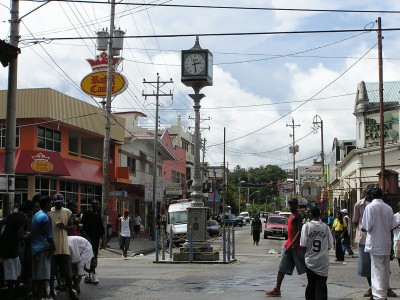 Arima Dial
Arima Dial
TriniView.com Reporters
August 13, 2005
Arima has always been regarded as the home of the Amerindians. Although it is difficult to find a 'pureblood' Amerindian within the district of Arima, or anywhere else in Trinidad, there is still evidence of their existence and the lingering impact of their cultural influence. Like many other regions in Trinidad, Arima, which emerged on the banks of what is known today as the Arima River, in fact received its name from an Amerindian word which means water.
Situated in North-central Trinidad it has been, for more than a century, the most easterly settlement in the interior of Trinidad. Nestled at the foothills of the Northern Range it has always served as a hub of commercial activity and transportation for the neighbouring areas, and for decades was the only gateway to the eastern seaboard.
Capuchin priests, who had ventured to this country to convert the Amerindians to Christianity as part of Spain's colonizing effort, conquered and claimed Arima in 1757, built a church and established a mission in the town. Ironically, the church was dedicated to Rosa, an Amerindian girl from Lima, Peru, who had been canonized as Santa Rosa de Lima.
In the 1780s, under the new Governor Josť Maria Chacon, Amerindians were forcibly removed from their lands in the nearby Arouca and Tacarigua and relocated to Arima in order to distribute their arable land among the newly arrived French planters. During that period, Arima was governed by a Cabildo or (Town Council), which was presided over by Manuel Sorzano. Sorzano Street, which was named in his honour, still exists as reminder of his rule. It is also the site of the Arima Town Hall, which houses the Mayor's office and is the official meeting place of the Council.
The Spanish laid down strict rules with the influx of French settlers and the enslaved Africans into Trinidad in the 1780s to keep non-Amerindians out of the Mission. This success was short-lived after the British conquered Trinidad in 1797. The restrictions seemed to have completely disappeared until in 1813, when Ralph Woodford became Governor under the British. Determined to preserve Spanish laws and customs he ordered non-Amerindians to leave the Mission of Arima and began to re-establish the Mission on its old footing. He supported the Cabildo of Arima in any move aimed at guaranteeing Arima as Amerindian territory.
In 1819, he received a complaint that Amerindians in Arima were charging extremely high fees for the rent of the land in the town. He supported the move of the Amerindians and stressed "strangers (Spaniards, Africans and French), had no rights in the area." Earlier in 1818, Governor Woodford appointed a military officer to oversee law and order in the town. Woodford instructed that all strangers who entered the village without his permission be apprehended. The military officer was also responsible for detaining anyone caught residing in Arima without Woodford's expressed authority.
Referred to as, 'Governor Chapeau Paille' because of his customary straw hat, Woodford journeyed regularly to Arima for the feast of Santa Rosa, celebrated on August 31, where he enjoyed himself with the Amerindians during the festival. After his death in 1828, those days were over and Arima was not preserved as a mission.
In the inevitable cultural clash between Spanish culture and influence and British rule, the Governors, who came immediately after Woodford, did not maintain the Spanish-founded missions, which were a stronghold of conversion to the Catholic faith. Those were the years just before the end of slavery and the Governors were focused on preparing for that crucial period and consolidating British cultural influence. By the 1850s, Arima, because of its strategic position had grown large enough to be regarded as one of the key villages in Trinidad.
In 1851, Arima received one of the first of the ward schools established that year under Lord Harris' education scheme. A carriage road was already in existence leading from Arima to Port of Spain but the 1870s brought further transformation to Arima when the cocoa industry began to spread into the central regions of Trinidad. Planters insisted on a system of improved transportation to get their goods into Port of Spain. And so, it was on August 31, 1876, that Arima saw the inauguration of the first passenger and freight railway line in Trinidad. On the first day of August 1888, Arima was granted the status of a Royal Borough.
Today, Arima still remains a town of great historical significance and is a main hub for persons residing along the north east area. Many activities such as the Arima Borough Day celebrations and the Feast of Santa Rosa are popular festivities in the area that attracts people from all over Trinidad and Tobago and the rest of the world. Still Arima and its surrounding areas houses some of the popular natural landscapes such as the Asa Wright Centre which is 12 km north of the town of Arima and which is one of the last natural tourist resorts in the country. Although the town of Arima continues to expand, it is hoped that the natural environment laying on the periphery would remain untouched and unspoiled.
Source: Towns and Villages by Michael Anthony
Arima in Pictures:
www.triniview.com/gallery/main.php?g2_itemId=105509
Links:
www.kacike.org
- Kacike: Journal of Caribbean Amerindian History and Anthropology
www.kacike.org/srcc/landreport.html#historical
- How the Amerindians of Arima lost their lands
www.centrelink.org/Trinidad_Tobago.html
- The Caribs of Trinidad and Tobago
www.centrelink.org/index.html
- Caribbean Amerindian Centrelink
Arima | Homepage | Special Events | Photo Gallery
|
